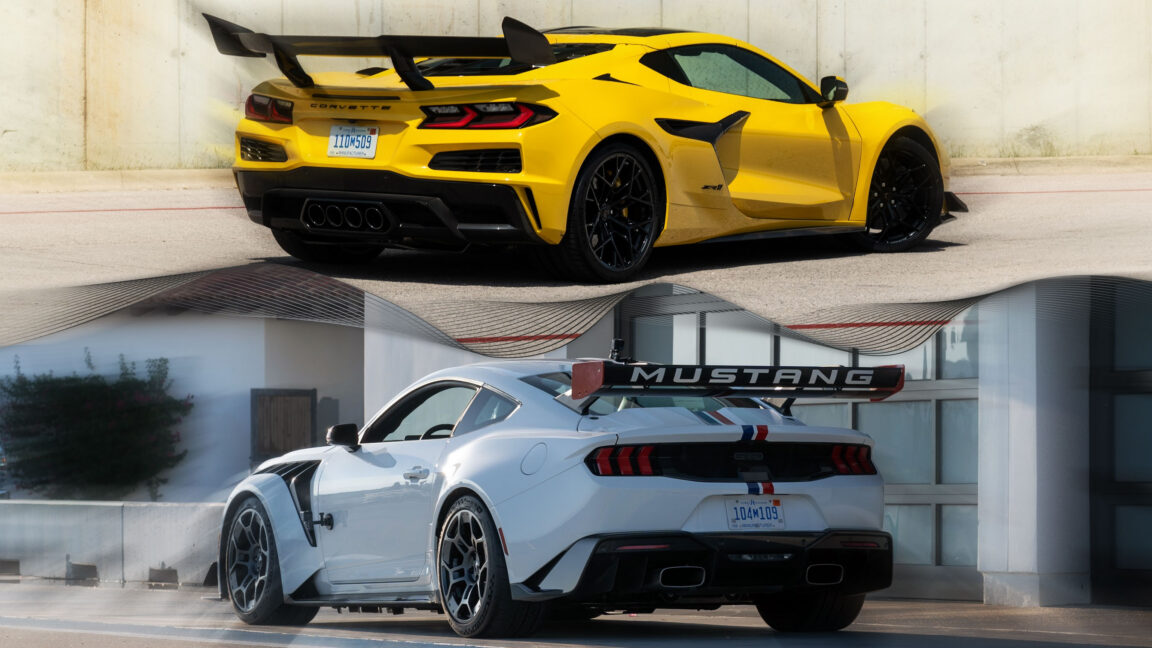
Image Source: https://cdn.arstechnica.net/wp-content/uploads/2025/09/corvette-vs-mustang-1152×648.jpg
The ZR1, GTD, and America’s new Nürburgring war is heating up as Ford and Chevrolet continue to push the limits of performance on one of the world’s most challenging racetracks. The Nürburgring, often referred to as the “Green Hell,” has rapidly gained prominence among American car manufacturers, with both Ford and Chevy striving to set record lap times that demonstrate their engineering prowess and performance capabilities.
The Rise of the Nürburgring Recognition
Traditionally, the Nürburgring has been a haunt for European car manufacturers testing their high-performance vehicles. However, recent events have marked a significant shift. Ford achieved a notable milestone by recording a sub-7-minute lap time with its Mustang GTD, clocking in at 6:57.685. Not long after, Chevrolet raised the stakes by achieving a jaw-dropping 6:49.275 lap time with its hybrid Corvette ZR1X, establishing itself as the fastest American car on the track.
The Mustang GTD: A Racing Machine Rebel
The Mustang GTD represents a radical departure from traditional Mustang designs. Built to resemble a road-going version of the Mustang GT3 racecar, the GTD offers a fascinating blend of power and handling. At its core, a powerful 5.2-liter supercharged V8 engine pushes out an astonishing 815 hp and 664 lb-ft of torque, making it the most potent road-going Mustang ever. In an engaging twist, the GTD includes advanced features such as a sophisticated suspension that allows the car to lower itself by 1.5 inches for optimal aerodynamic performance.
Engineering Brilliance
Collaboration with Multimatic, the team behind the Ford GT, enables the GTD to maintain cutting-edge engineering. Modifications have removed parts of the chassis to improve weight distribution and performance, culminating in a vehicle that weighs over 4,300 lbs yet boasts exceptional cornering grip and stability.
The Chevrolet Corvette ZR1: Performance Refined
The Corvette ZR1, meanwhile, stays true to its roots while venturing into new performance territories. With a breathtaking 1,064 hp from its 5.5-liter twin-turbocharged V8 engine, the ZR1 has consistently showcased the capabilities of American engineering. The model retains the characteristics of the legendary Corvette while integrating modern aerodynamics that enhance both speed and control on the track. Starting around $175,000, owners are treated to a vehicle that both accelerates rapidly and offers refined handling.
Aiming for Records
Chevrolet’s innovative mindset allowed the ZR1 to seamlessly adapt and become a competitor at the Nürburgring. Vehicle dynamics engineer Drew Cattell managed a record-setting lap that exemplified the hard work the team put into optimizing every inch of the car. Unlike the extensive alterations to the GTD, the ZR1 maintained its core design while achieving unprecedented performance metrics.
The Nürburgring: A Proving Ground for Excellence
The battles between the Mustang GTD and Corvette ZR1 at the Nürburgring go beyond mere competition; they symbolize the shift in American performance philosophy. Both manufacturers have committed to pushing the envelope regarding what is possible in automotive performance, exploring advanced aerodynamics, powertrain innovations, and performance engineering.
A Healthy Competition
In what has become a friendly rivalry, the teams at Ford and Chevy respect each other’s endeavors to push the boundaries of their capabilities. Ford’s chief program engineer, Greg Goodall, acknowledged that this competition is not just about winning; it’s about elevating their performance standards. In a world where every second counts, both brands aim to refine their vehicles for thrilling outcomes.
What Lies Ahead? The Next Chapter in the Nürburgring Saga
As both the Mustang GTD and Corvette ZR1 continue to evolve, the world watches in anticipation. The Nürburgring war signifies more than just lap times; it’s a testament to generations of American engineering that strive to keep pace with the global automotive scene. With each passing lap, Ford and Chevy drive not just cars but innovation, passion, and the thrill of competition.
Further Rivals on the Horizon
As the rivalry escalates, one can only speculate what each brand has planned next. With spurred excitement in the performance car sector, this competition at the Nürburgring might lead to even more groundbreaking designs and technologies.
FAQ Section
What are the lap times for the Ford Mustang GTD and Chevrolet Corvette ZR1?
The Ford Mustang GTD recorded a lap time of 6:57.685, while the Chevrolet Corvette ZR1 achieved a time of 6:49.275 at the Nürburgring.
What makes the Mustang GTD unique?
The Mustang GTD is designed as a road-going interpretation of the Mustang GT3 racecar, featuring advanced aerodynamics and a supercharged V8 engine generating 815 hp.
How does the Corvette ZR1 compare to the GTD?
While the ZR1 boasts higher horsepower at 1,064 hp, the GTD emphasizes its handling and aerodynamics, offering a different kind of driving experience.
How has the Nürburgring’s perception changed in America?
The Nürburgring is becoming more prominent for American manufacturers, with increasing participation and official lap times being recorded, signaling a shift in competitive strategy.
What are the future implications of this rivalry?
This healthy competition between Ford and Chevrolet encourages innovation and advancements in automotive engineering, promising exciting developments in the performance car arena.
